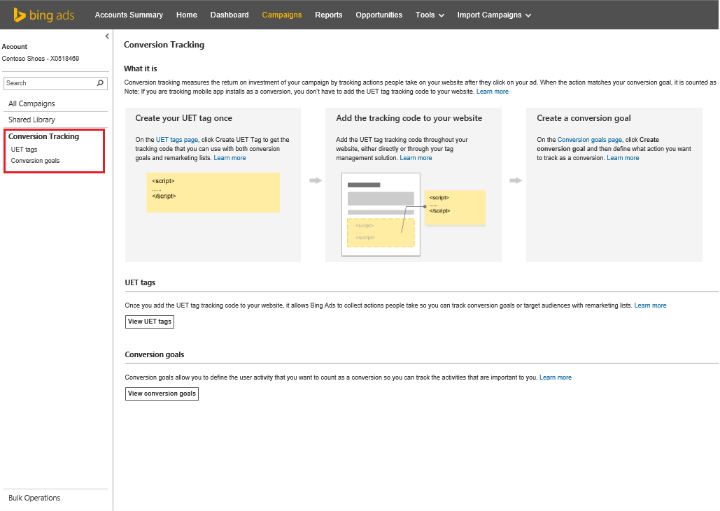Bing Ads recently announced a number of improvements to Universal Event Tracking (UET), the fairly new conversion and goal tracking, that will also soon power retargeting on search.
If you haven’t yet implemented UET, there is now a simplified workflow and documentation that will make it easier to get started and understand how it works. Likewise, if you are still using legacy Campaign Analytics tags, Bing has added several similar features and other efficient enhancements that will ease the transition to UET. There have also been adjustments made based on advertisers suggestions, and pain points, who have already been using UET for conversion tracking over the last few months.
New UET Improvements
Based on customer feedback Bing Ads focused on two main areas for improvement: workflow and ROI. When whittled down, conversion tracking should be easy to use and it should help you achieve a higher ROI.
Workflow Improvements
The first improvement is individual management of UET Tags and Conversion Goals. Managing both UET tags and Conversion Goals was formerly embedded in Goals and Conversions page under Shared Library. There was no way to create a tag without creating a conversion goal or view all the tags created in a collective way.
Bing has now separated UET Tag and Conversion goal management into unique pages, UET Tags and Conversion Goals. These two new pages are listed under a new group called Conversion Tracking, which you can see below.
The second workflow focused update involves better revenue tracking. Bing Ads has allowed the tracking of revenue associated with conversions. The new update gives more control and insight into tracking options. You can assign unique values to differing levels of conversions such as a sign-up as opposed to a purchase.
Thirdly, Bing has enabled Inline Alerts, a pop-up reminder of the next steps that will assist you in the process. An example Bing suggested, is when you create a custom event type goal, there will be a reminder for you of the need to customize UET tag tracking code to report custom events.
The last workflow improvement is the addition of the help pop-up box, noted with a ![]()
symbol, throughout the UI.
ROI Improvements
First off, support for Unique conversions has been created. Bing is now enabled with the flexibility to count conversions according to your needs. When you are creating a conversion goal, there is now two options for the Count property, All and Unique conversions.
- All Conversions – this will count all conversions that happen after a click. If you are tracking purchases as conversions, this is the best option to use.
- Unique Conversions – this will count only one conversion that happens after a click. This is a good option if you want to track the number of unique leads generated on your website as a conversion.
Note: All your existing conversion goals will default to All conversions. You can edit those goals if you want to change them to Unique conversions.
The second update Bing has made in hopes to improve campaign performance, is account level conversion goals. You will now have the choice to identify if a conversion goal is at the account scope or across all accounts via the new Scope property.
If you manage several accounts that are using campaigns that all send users to a single website when they click on your ads, set Scope property to “Across all accounts.”

If varying accounts lead users to different sites, the Scope property should be set to the current account in context so that conversions that happen on different website are accurately tracked and attributed to clicks from their corresponding accounts only.
Note: All of your existing conversion goals will have the scope of “Across all accounts.” Bing does not allow you to edit scope property. Create a new conversion goal to set up account level goals.
Next up is the tracking status of UET Tags and Conversion Goals. You can now verify in the Bing Ads UI the status of your tags and goals. The tracking status column has been added to both the UET Tags page and the Conversion Goals page to inform you if your tags are reporting user activity and if goals are counting conversions.
- UET Tags page
- Conversion Goals page
The fourth update you will see is conversion, revenue and repeat rate data in the Conversions goals page. You can now see this data in your selected time period, for each conversion goal that you have created in the Conversion Goals page, as shown below.
Next, to make it easier for you to define conversion goals based on the presence of a string in the URL visited by the user on your web site, we have introduce the support for “Contains” clause. You can see this option when creating a conversion goal of type Destination URL and Custom Event. This should reduce the need for using regular expressions in your conversion goals.
The final update is the elimination of rarely used columns from performance reports. To advance the proficiency of the Bing platform and to provide conversion related reports in a timely manner, Bing is eliminating columns from conversion-related performance reports which were seldom used, but expensive to produce. They will be removing the Bounce rate, Avg pages/visit, Total visits and Avg. visit duration metrics from performance reports. In addition, Spend and ROAS columns from the Goals report will also be eliminated.
With all the above improvements to the UET, Bing Campaign Analytics will be shut down in the coming months and you should transfer over to UET based conversion tracking as soon as possible.










